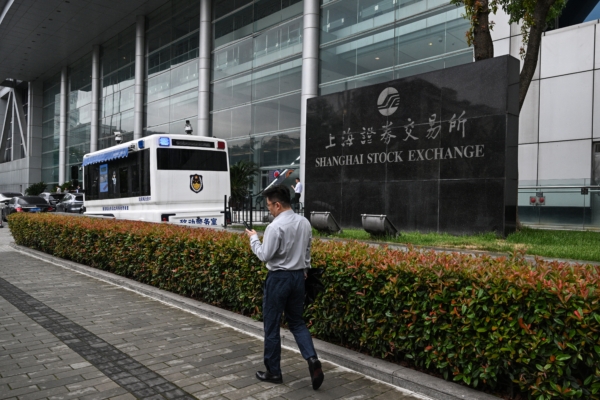China’s stock market experienced a six-week continuous drop, with the Shanghai Composite Index falling below the 3000-point mark once again. After a rebound followed by more declines, the first half of the year concluded on June 28th (Friday) with the market failing to regain the 3000-point level. Some analysts believe that the Chinese economy is struggling, and the stock market cannot see a turnaround as the Communist Party’s “stability maintenance” measures to rescue the market are unsustainable.
On the afternoon of the 28th, the key indices in Beijing, Shanghai, and Shenzhen all opened lower but later experienced a volatile rebound. By the close of trading, the Shanghai Composite Index closed at 2967 points, up by 0.73%. This was the second rebound after falling below 3000 points, but it did not surpass the increase seen during the first rebound on the 26th.
While global stock markets hit new highs in the first half of the year, the Chinese stock market performed poorly, with all three major indices falling. Out of over 5300 listed stocks, less than 800 saw price increases.
The Shanghai Composite Index has repeatedly dipped below 3000 points since February. The recent market decline started on May 20th, with the Shanghai Composite Index hitting a low of 2933.33 on June 21st.
On the 26th, amidst volatility, the key indices rebounded, with over 4500 individual stocks rising. The repurchase of stocks by state-owned and enterprise stocks played a role in the rebound.
Investors sighed with relief as the stock market turned green (upward) after over a month of decline. However, contrary to some investors’ expectations, the market saw broad declines again the following day.
On June 27th, the A-share market opened low and remained bearish throughout the day, with more than 4700 individual stocks declining. The trading volume in Shanghai and Shenzhen continued to shrink for three consecutive days.
Calls for the government to intensify market rescue efforts resurfaced, highlighting the recurring trend in the Chinese stock market in recent years.
Since the sharp decline in the Chinese stock market in February, the Chinese Communist Party has introduced consecutive new policies to vigorously “rescue” the market. However, the artificial bull market created through these measures is unsustainable, as viewed by investors worldwide.
According to LT, a senior financial expert, the government’s efforts to prevent market downturns by prohibiting short selling, limiting major shareholders’ share reduction, and halting new stock issuance are non-market behaviors that cannot be sustained. Therefore, the recent resumption of new stock issuance resulted in the market’s decline, indicating the fragile foundation of the Chinese stock market.
Why has the Chinese stock market turned into a quagmire with no way out?
Qin Peng, a commentator based in the United States, pointed out various reasons behind the recent dip below 3000 points in the Chinese stock market. Fundamentally, the stock market reflects the overall domestic and international political and economic environment. Given China’s overall economic decline, a positive outlook for the stock market is unlikely. The government’s market intervention has not addressed the root economic issues, making its effects limited.
Qin Peng analyzed that the current focus on rescuing the real estate market, promoting export expansion, and superficial consumer incentives without significant direct monetary stimulus shows a lack of substantial economic recovery efforts. Moreover, private enterprises, as significant investment entities in China, have reduced their investments significantly. In a stagnating economy, discussing market rescue is merely rhetoric.
Furthermore, the structure of the Chinese stock market, designed by the elite to raise funds and manipulate stocks through dubious practices such as IPOs and share offerings, lacking proper legal oversight, has contributed to its deterioration. Investors have been repeatedly misled, resulting in disappointment and financial losses, leading many to withdraw from A-shares.
Industry experts generally agree that the stock market tends to follow economic trends. For sustainable market rebound, China needs economic recovery and a restoration of corporate profits, which currently seems challenging.
The latest official data released by the Chinese government indicates a dire economic situation in the country.
The real estate sector, a significant pillar of the Chinese economy, remains dismal despite various government measures to stimulate property sales. In May, house prices in major cities dropped at the fastest pace since October 2014.
The vibrant dining industry in China is facing severe setbacks as well.
Data from China’s National Bureau of Statistics released in April revealed a significant increase in the closure of dining establishments, with around 180,000 restaurants shutting down in March alone.
Moreover, the latest figures from the Chinese Ministry of Finance show a 5.1% year-on-year decrease in total tax revenue from January to May, while non-tax revenue increased by 10.3%. This indicates significant fiscal challenges and a noticeable rebound in excessive fees collected by local governments.
Foreign direct investment in China has also plummeted significantly.
The latest data from the Chinese Ministry of Commerce reports a 28.2% year-on-year decrease in actual foreign investment in China from January to May, with May marking the twelfth consecutive month of declining foreign direct investment.
Simultaneously, with the accelerated depreciation of the Renminbi, substantial capital outflows from mainland China towards Hong Kong have been observed. This has resulted in record-level Renminbi deposits in Hong Kong, while mainland Chinese investors are seeking higher returns through limited offshore investment channels.
LT Vision pointed out that although Hong Kong’s economic situation is challenging, it still appears slightly better compared to mainland China, motivating many investors to explore alternative options and emphasizing the general disillusionment with the Chinese market.
In conclusion, the dire state of China’s economy, as evidenced by official statistics, indicates a grim future. The cosmetic approach of the Communist government to prop up the stock market without addressing underlying issues is futile, as temporary measures cannot provide lasting solutions.

